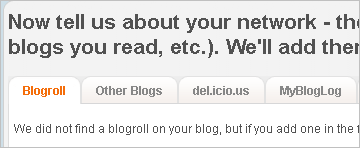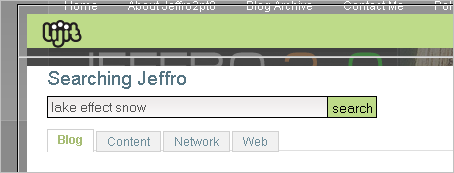ProBlogger - Latest Posts |
| Is Your Blog Search Lijit [REVIEW] Posted: 27 Nov 2008 08:02 AM PST
Search on blogs is a relatively simple concept. You type in a few keywords related to a post and results are presented to you that are local to that blog. However, what if you could extend the functionality of the search function to go beyond your blog to cover the videos you have published on YouTube, your Twitter account, bookmarks, network of friends, and the blogs you read in your RSS reader? That’s exactly what Lijit enables you to do. Company Info:Lijit is based out of Boulder, CO which is a surprise to many considering silicon valley is typically the home for most Internet based businesses. Using the power of people, their content, and their connections, Lijit aims to enhance the way your readers search for and discover information on the Internet. You serve as a filter for all of the results your readers could possibly receive, ensuring they only receive the most relevant results from the source they trust. That source being you. Signing Up And Configuration:Before we get things underway, be prepared to spend 15-30 minutes to not only create an account but also to configure the search widget. The first thing you’ll need to do is submit your blogs URL. Once you provide the URL, the next configuration page has a list of services that are grouped by purpose. For each site/service that you have an account with, you’ll need to tell Lijit what your user name is for that service. If you have an account with a site that is not listed, Lijit does provide an option for you to provide a link to a URL, RSS, or OPML feed which will be added into the search results.
Once that is done, the next page is all about adding your network to your account. This network consists of your MyBlogLog account, the blogs you read, your blogroll, del.icio.us, Lijit users etc. This extended network is also added to your Lijit search engine. The third configuration page is where you get to create your user account. After you create your account, Lijit will take all of the information you provided and mash it all together into a personalized search engine. After your search engine is created, you’ll have a chance to configure the look and feel of the search widget so it looks good within your blog theme. Customization options include choosing widget styles, color palettes, logo colors, choosing what is displayed such as content icons or popular searches within a cloud and re-search. Re-search is described by Lijit as:
Installing The Widget:Lijit supports TypePad and WordsPress out of the box. For sites such as Tumblr, LiveJournal, etc, there is a piece of javascript that can be used to install the widget on your blog. Considering my personal blog is WordPress based, you know which I one I chose. Lijit provides a WordPress plugin which is installed like any other plugin. Simply unzip the file, upload it to your WordPress plugin directory and activate it. Then guess what. You have to log into your WordPress administration panel and perform some more configuration options.
Thankfully, configuring the widget is a pretty simple process. One of the cool features of the plugin is that, you can choose to either use the standard Lijit Widget which appears in your blogs sidebar or you can substitute the WordPress search function with the Lijit search. Service In Use:After all is said and done, take a look at your blogs front page and perform a search via the Lijit search box. A Light-box style window should pop up which displays the results. It’s pretty easy to see how Lijit is monetizing the service as they have ads served by Google on the right hand side as well as above the search results.
The search result window provides at least four different tabs from which to perform a search query. By default, the blog url is searched. However, users can choose to search via your content, network, or the web itself. Of course, if people were going to search the web, I’d think they would do that from the Google Homepage. After performing a few test search queries, I found the search results to be pretty accurate. One of the cooler features found within the search results is that, there is a link underneath each result that is labeled “What’s The Connection“. Upon clicking on the link, you’ll see how the result is connected to the search engine. A great feature to have, especially when visitors are performing searches through the Content or Network tabs. If you feel unsatisfied with the results that Lijit provides, there is a link at the bottom of the page which takes you to the their feedback page. The topic is automatically filled in with what you were searching for enabling the team to focus their efforts on that specific search query for your domain. Stats:One nice thing about Lijit that the default WordPress search bar doesn’t do is give you statistics. Lijit provides an entire area for statistics that is tied to your account. You can track how many searches are performed on your blog, the keywords that were searched, total searches, geographical location, page views, your exposure and much more.
In fact, the exposure tab actually notified me of people that were linking to me that I didn’t know about previous to using the service. Although in at least one case, Lijit picked up on some links that were old and when clicking on the pages that supposedly had a link to my blog, I received a 404 error. Conclusion:I’ve seen a number of big name blogs using Lijit for quite some time now, including this one. In my opinion, Lijit has two killer features wrapped in one. The first being control. End users are in control of what appears in their search engine which leads me to feature number two. The ability to create a personalized search engine that only taps into your blog content, but can be customized to search all of the content you have produced on other sites/services across the web. On top of that, you can then add blogs that you read and or trust to your search engine which is then used by your readers. Hopefully, other people have added your own blog to their personalized Lijit search as this all means there is a possibility of receiving traffic not only from Google, but from personalized Lijit search engines as well. If there was one thing I don’t like about the service it would be the way in which search results are displayed. Instead of the search result shown in a window that seems like a popup, I would much rather have the results displayed as if they were natural to my blog. For instance, I’d love it if they provided a way for me to add a bit of code to my WordPress themes search result template page. Not sure how difficult that would be, but at least the results would look natural. Other than that, I can easily see why some of the biggest names in blogging are using Lijit. Things To Look Forward To:During the course of this review, I was able to get in touch with Micah Baldwin who is VP of Business Development and he gave me the lowdown on some things that Lijit is working on behind the scenes.
The future looks bright for Lijit. Be sure to let me know in the comments if you currently use Lijit on your own blog and if you prefer it over the default search engine that comes with your publishing software of choice. Tags: blogs, lijit, review, search, services |
| You are subscribed to email updates from ProBlogger Blog Tips To stop receiving these emails, you may unsubscribe now. | Email delivery powered by Google |
| Inbox too full? | |
| If you prefer to unsubscribe via postal mail, write to: ProBlogger Blog Tips, c/o Google, 20 W Kinzie, Chicago IL USA 60610 | |







Tidak ada komentar:
Posting Komentar